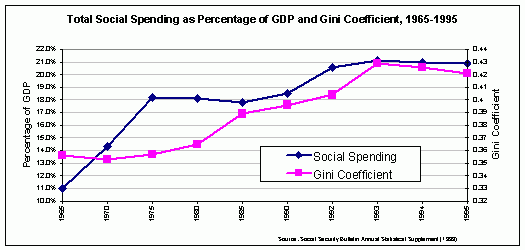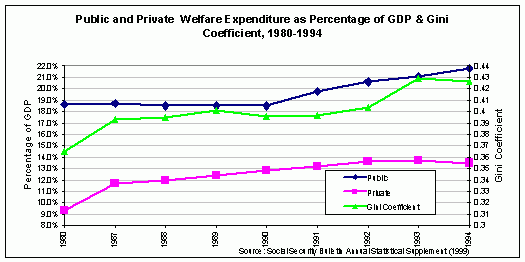In previous essays, I have argued that a) we may not be measuring inequality correctly and that a proper conception of the concept may lead us to the conclusion that inequality is actually decreasing, and b) that even if inequality is increasing, it is unclear that it is necessarily detrimental to society. Here, I will show that the data on the American welfare state do not support the hypothesis that the state can reduce inequality.
Let's go ahead and assume that income inequality is the proper metric by which we gauge true material inequality. Let's also assume that we have a non-egalitarian outcome produced by the unhampered market in which the outcome is the result of peaceful exchange between consenting parties. First, we have to consider the grounds on which we propose to redistribute goods. If, in fact, all property is justly acquired, then the only criterion by which we can justify intervention and redistribution is simple envy.1
It has not been shown (it has merely been asserted) that this is an appropriate ethical criterion; moreover, it must be rejected even by the most rigid Benthamite utilitarian because admitting envy as a sufficient condition for aggression and redistribution admits with it a whole host of unsavory things. But lest it appear that I'm ducking the issue, let's go ahead and assume that inequality is acute, inequality is growing, and inequality is unambiguously bad. I will proceed to show that the U.S. government's track record leaves us no reason to be sure that the state can successfully reduce inequality.
The argument will be inductive, and it is important to lay out ahead of time what we cannot conclude from the numbers and graph to follow. First, we will not be able to conclude from this evidence alone that inequality would not have been higher in the absence of state action. Second, we will not be able to conclude that state intervention caused the increases in inequality that we observe since the beginning of the "Great Society" welfare programs of the 1960's. We will be able to conclude that state action, in the form of increased social spending, has not reduced inequality; if anything, the relationship between social spending and inequality appears to be positive.2
One of the most popular measures of income inequality is the Gini coefficient, which is a number between zero and one that shows us how income is distributed across groups. A Gini coefficient of zero indicates a perfectly equal income distribution, and inequality is said to increase as the Gini coefficient gets higher. The graphs below show us that inequality, as measured by the Gini coefficient (right axis), is higher today than it was at the start of the "Great Society" welfare programs of the 1960's—this is in spite of large increases in social welfare spending at both the public and private levels (measured as percentage of Gross Domestic Product on the left axis).


There is a clear positive correlation between social spending and inequality (see note 19, above), which suggests one of three things: the state's efforts to reduce inequality have been ineffective, increasing inequality is inspiring additional (and still ineffective) state action to combat it, or additional social spending is causing more inequality (unlikely). No matter what conclusion one draws, it is clear that the U.S.'s "Great Society" welfare programs have not reduced income inequality. It is not clear from the data that greater increases in social spending will alleviate income inequality.
In the preceeding essays, I have done three things. First, I have argued that our discussion of inequality is informed by improper metrics—in other words, we're measuring the wrong things. We should be looking at the substitutability between types of goods available for consumption rather than simple income figures.
Second, I have shown that the United States outperforms Sweden, the classic Scandinavian welfare state, on a number of quality-of-life margins. Finally, I have shown that state efforts to reduce inequality and poverty have been, at best, ineffective.
Everywhere we turn, the prophets of doom are telling us that the market economy sows the seeds of its own destruction by generating unequal distributions of income. It just might be that these prophets of doom—whether they prophesy from the pages of the Los Angeles Times or the American Economic Review—are incorrect.
- 1The "all property is justly acquired" provision is important. If the mode of distribution is the result of coercive interaction, then the policy conclusion is entirely different. This, however, is a separate issue.
- 2Caveat: one cannot conclude that the relationship is positive; both may simply be following an upward time trend.

